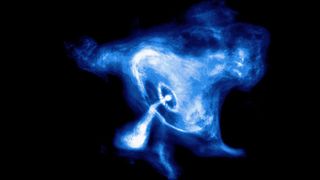Watch 2 gorgeous supernova remnants evolve over 20 years (timelapse video)
You can see shockwaves rippling through the remnants.
When we picture what's in deep space, we often think of static images — colorful composites of distant objects like nebulas and galaxies, frozen in time. The reality is that everything is moving, and it's moving fast. But given the vast distances involved, it's hard for us to see that motion.
NASA's Chandra X-Ray Observatory, however, has been taking images for decades — long enough to compile timelapses that show the movement of deep space objects. And the team has just released two such "movies," one of the iconic Crab Nebula and one of Cassiopeia A (Cas A).
The Crab Nebula, located some 6,500 light-years away from Earth, formed after a supernova explosion occurred long (long) ago. Astronomers originally witnessed the event in 1054 A.D. Using Chandra images taken over 22 years, the timelapse shows the ring-shaped shockwaves emanating from the superdense, rapidly rotating neutron star at the nebula's core, creating ripples through the surrounding environment. Because of this rotation, the neutron star is also considered a pulsar, and jets of matter shoot out from its poles.
Related: The Chandra X-ray spacecraft may soon go dark, threatening a great deal of astronomy

Cas A is another supernova remnant; it's located about 11,000 light years away. Its explosion was witnessed on Earth around 340 years ago. In the new Chandra timelapse, its expanding outer region shows the initial blast wave making its way out into space. Multiple shock waves (akin to sonic booms from airplanes flying faster than sound) move in opposite directions while rippling through the remnant, which you can see in the video. For this timelapse, 19 years of Chandra observations were strung together to capture the motion.
While Chandra is scheduled to take new images of the Crab Nebula this year, the future of the observatory is bleak. Given NASA's proposed budget for upcoming years, Chandra faces an early demise, its operating budget shrinking tremendously in the near future. But the budget is simply a proposal for now, and perhaps the outcry over Chandra in the astronomical community will change the tides before it's set in stone.
Get the Space.com Newsletter
Breaking space news, the latest updates on rocket launches, skywatching events and more!
Join our Space Forums to keep talking space on the latest missions, night sky and more! And if you have a news tip, correction or comment, let us know at: community@space.com.

Space.com contributing writer Stefanie Waldek is a self-taught space nerd and aviation geek who is passionate about all things spaceflight and astronomy. With a background in travel and design journalism, as well as a Bachelor of Arts degree from New York University, she specializes in the budding space tourism industry and Earth-based astrotourism. In her free time, you can find her watching rocket launches or looking up at the stars, wondering what is out there. Learn more about her work at www.stefaniewaldek.com.
-
ArtStreet Where's the timelapse? Is it supposed to be embedded in the page? If so, something's wrong with the render, it's not showing up. If you have the link to the timelapse, please post that.Reply
